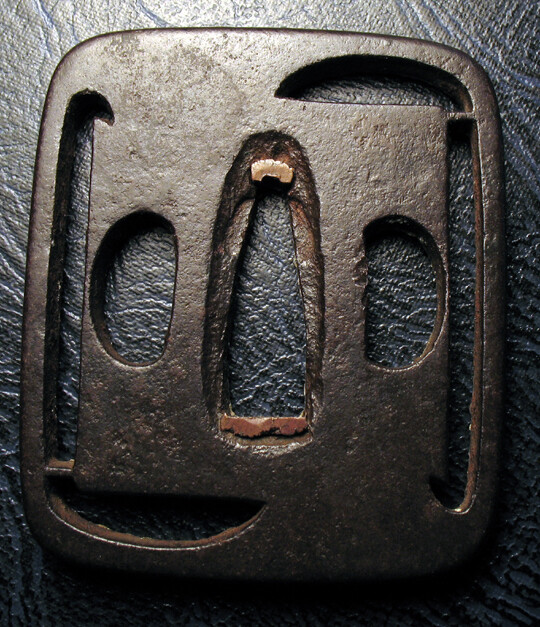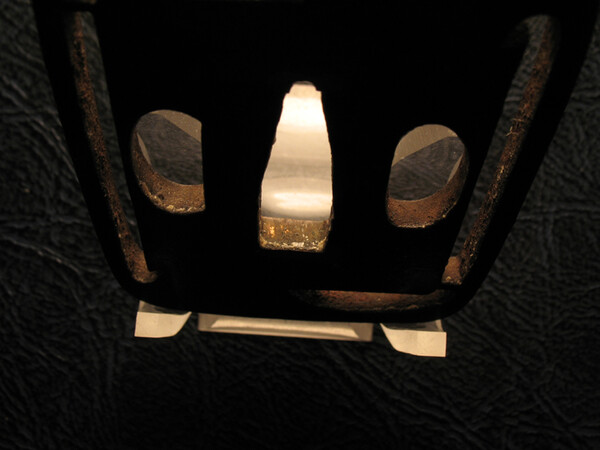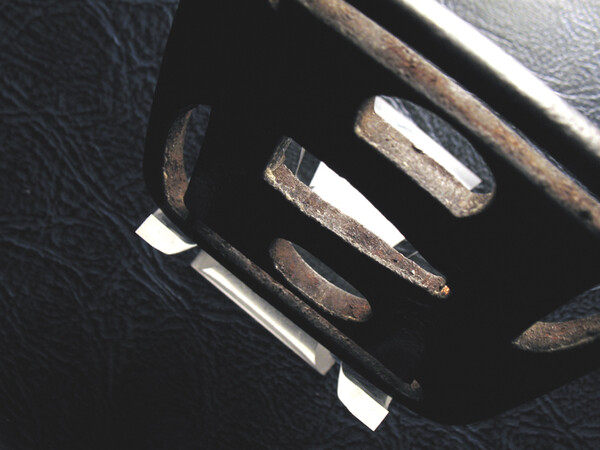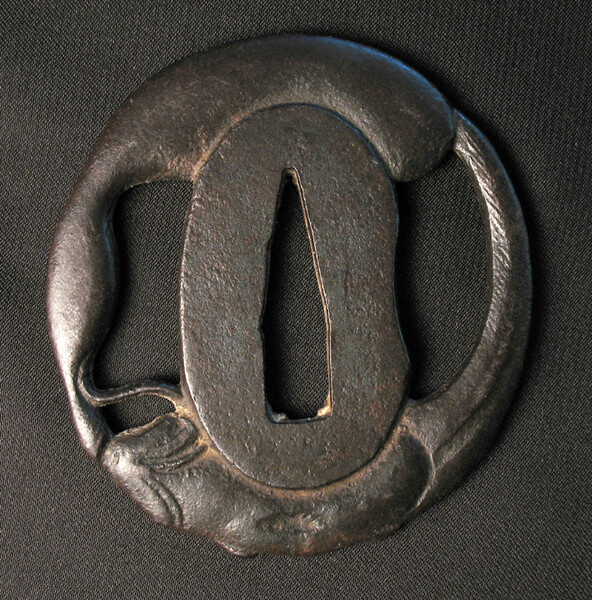-
Posts
189 -
Joined
-
Last visited
Content Type
Profiles
Forums
Events
Store
Downloads
Gallery
Everything posted by cspage
-
Thanks you all. I think I will stick with Grey's suggestion and leave it as is. No sense in going looking for trouble. Colin
-
I just bought a nifty little tsuba that appears to have a surface finish of some sort that has apparently left a white residue at the edges where it has lapped into the various ana of the tsuba. The finish can be also be distinguished from the raw iron in the cuttings of the nakago ana where those closest to the surface received the finish and the deeper ones toward the top of the nakago ana show the raw iron. Any info, or even guesses, on this finishing of the surface would be appreciated. Thanks. Colin
-
Here is a description from Andy Quirt of a Hirotaka papered Wakizashi I purchased from him some years ago (mumei): "Echizen Hoki no Kami Hirotaka was active around Meireki (1655 - 1658). He was of the Echizen Shimosaka school, and his style is close to that of Harima Daijo Shigetaka. He is rated Chujosaku in Nihon Toko Jiten - Shinto Hen by Fujishiro, valued at 3,500,000 yen in Shibata's Toko Taikan, and listed with a double triangle in Nihonto Meikan." (I didn't see any dates mentioned above) Colin
-
While everyone's comments about this "tsuba" are analytical as to its construction age and authenticity as a tsuba, no one seems to have anything to say about the aesthetics other than Geraint, " Whatever else is causing concern the placement of the decoration derives from the source of the metal rather than any design intention," and "what a way to go." I would differ from that in that the design intention appears to be very considered. The placement of the "zogan" in relation to the format, the ana, etc. appears to be thought out and deliberate. While not "traditional" in any sense, it does reflect perhaps a more modern composition (I almost said "western composition," but that would just open up that old and worn out can of worms). And as far as "what a way to go," it may not be a tsuba, but it is interesting and perhaps even nifty in its own right. Just my 2 cents. I am now running away quickly. Colin
-
Not to be too picky, but that insect looks much more like a locust or garden variety grasshopper than a mantis to me. Am I missing something? Just an observation. Colin
-

Online Arthur Church tsuba collection at the Ashmolean
cspage replied to growlingbear's topic in Tosogu
Wow. Not only a good site, but really sweet tsuba. Check out the Tsuba with egg fruits in the "Akao school of Echizen and Yedo" section. Colin -
Having been head-on dive-bombed by a large dragonfly while canoeing the Pudding River in Oregon (a butterfly had landed on my hat), I can attest to the aggressiveness, lightning strike attitude of these magnificent insects (the butterfly escaped the initial strike due to my chicken-hearted duck, rose above the river and was summarily...taken); a worthy symbol of the Samurai. Colin
-
Hah! So you're the one who got that Yamakichibei, David. I had my eyes on that for so long and violated my best rule of life, "Take tarts when tarts are passing." Congrats. It found a good home. Nice photos. Colin
-
Samurai! Armor from the Ann and Gabriel Barbier-Mueller Collection will be be on exhibit at the Portland Art Museum, Portland, Oregon, USA Oct 5, 2013 to Jan 15, 2014. Here's the Museum's blurb: Travel back in time and discover remarkable objects that illuminate the life, culture, and pageantry of the samurai, the revered and feared warriors of Japan—from one of the finest and most comprehensive collections in the world. Samurai! Armor from the Ann and Gabriel Barbier-Mueller Collection presents a treasure trove of battle gear made for high-ranking warriors and daimyo (provincial governors) of the 14th through 19th centuries. The exhibition illustrates the evolution of the distinctive appearance and function of samurai equipment through the centuries and examines their history. Portland is the only West Coast venue for Samurai! Just FYI. Colin
-
David, I have always enjoyed the photography on Moses Becerra's website. Not only do they give a clear depiction of the koshirae, but also, in the more artistic images, lend a sense of the experience one might have actually handling the koshirae, looking at it from different angles. Obviously a very professional job. http://www.nihontoantiques.com/fss564.htm Colin
-
The fukurin is interesting. One is always curious to see underneath to find out the reason. Here is a like tsuba of mine that is not so well worn, no fukurin, probably not as old. Colin
-
Just a couple of thoughts, referring to Ford's comments. I assume fakes are made primarily in order to make money (I may be wrong, fakes might be made just to prove it can be done). It might prove interesting to find out the financial history of this tsuba. Next, if making a fake, why be so obvious as to abuse the patina so much. Would not a more creditable patina reap more lucre on a piece such as this were it a fake? Please note I'm not making any judgements on the tsuba, just asking questions. Colin
-
Hah! If nothing else, this tsuba is entertaining. I hope others have some good info to share. Colin
-
OK, Lorenzo, I bow to your strict aherence to protocols of the experts. "In the style of" is fine with me. However, common sense, which I heartily believe in, tells me that the preponderance of evidence points towards the possibility of authenticity. Just my opinion, think of it what you will...but... ...a "treasure/gem" is in the eye of the beholder, and having been educated and trained in the visual arts and crafts, I believe my eye is pretty damn good. My enjoyment of this tsuba is strictly a personal, and while I would hope others might likewise enjoy it, I make no pretentions of deciding how others should think about this piece. Sorry if the syntax gave a different impression. "You can't have one of the greatest higo master work this cheap and if you do than the seller is probably insane." Are you refering to the price it was sold for? If so, I'm sorry you feel that Skip Holbrook and Grey Doffin are probably insane. Colin
-
Dirk, any chance of you posting some pics here? It would be fun to seen them. Colin
-
Dirk, I'm overwhelmed with this wonderfully rich enlightenment of the catfish/gourd motif. Thank you so much! You are a scholar and a gentleman. Colin
-
Thanks, David. I really like this tsuba, too (obviously). The catfish is is fishy and the gourd has a beautiful, organic aspect. Quite fetching. I'll take this opportunity to also mention there's one text that states that Matashichi had up to 20 workers in his shop, so whether this is made by the individual master or one of his "workers" is really not important (signatures were apparently rare). The quality of work was obviously of high importance and I expect that whomever of the group made this tsuba, it had to pass muster with the boss. Colin
-
"If my old eyes are still working correctly, the TSUBA shown is not the same as pictured in the KANSHOKI. Nevertheless it is pleasant." Jean, definitely not the same tsuba, but the book illustration was included to show similarities and to support the supposition that this is of the Higo Hayashi Matashichi school. The book mentioned many tsuba with this design. The book illustration does not include the dimensions of that tsuba (at least not in English), so, if the illistrated tsuba is katana sized, one can see the modifications of scale required to duplicate the design in a smaller version. I find that also interesting. Colin
-
Lorenzo, definitely tekkotsu. You can see the catfish fin to the right of the tekkotsu. I am not stating that it is "surely made by Hayashi Matashichi." I simply stated that it "appears so." Far be it for me to claim expertise in this field. Skip Holbrook is the one who labeled the tsuba as such, and coupled with the example in Tsuba Kanshoki, which, by the way, also mentions that this design appears in many tsuba by the Matashichi school, and the written descriptions of the characteristics of this school, the preponderance of evidence points in that direction. Thanks for the questions. Colin
-
Again, this is just for everyone's pleasure. Here is what I think is a gem that I recently purchased from Grey. Higo Hayashi Matashichi, according to Skip Holbrook, and from my limited experience in books, it appears so. Small tanto sized tsuba, marvelous patina and a bone on the rim. The book page is from Tsuba Kanshoki, page 176. Colin
-
I vote for ko-tosho also. Yes, common diameters seem to be 8+ to 9+ cm, there are also smaller examples out there. Yamabushi Antiques had one under 7cm once. If there's argument for another attribution, I will be interested in reading it. Coliin
-
Just my humble opinion, Brian's observation and demonstration of the duplicated indentations/flaws is pretty convincing that the tsuba in question must be at least some generation of a cast knockoff of the one in the book. Logic must prevail. I hope Brian's observations are addressed in the final court's opinion. Colin
-
Wow. I am totally impressed with the cleaning of this tsuba. This is a lovely tsuba. Colin
-
Thank you, Christian. This is very good information and has added much to my education in the subject. One more step forward. This is much appreciated. Thanks again. Colin










